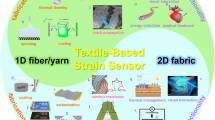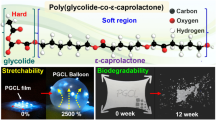Abstract
Determination of dynamic tensile response of soft materials has been a challenge because of experimental difficulties. Split Hopkinson tension bar (SHTB) is a commonly used device for the characterization of high-rate tensile behavior of engineering materials. However, when the specimen is soft, it is challenging to design the necessary grips, to measure the weak transmitted signals, and for the specimen to achieve dynamic stress equilibrium. In this work, we modified the SHTB on the loading pulse, the equilibrium-monitoring system, and the specimen geometry. The results obtained using this modified device to characterize a soft rubber indicate that the specimen deforms under dynamic stress equilibrium at a nearly constant strain rate. Axial and radial inertia effects commonly encountered in dynamic characterization of soft materials are also minimized.









Similar content being viewed by others
References
Song B, Chen W (2003) One-dimensional dynamic compressive behavior of EPDM rubber. Trans ASME, J Eng Mater Technol 125:294–301.
Song B, Ge Y, Chen W, Weerasooriya T (2007) Dynamic and quasi-static compressive response of porcine muscle. J Biomech 40:2999–3005.
Chen W, Lu F, Frew DJ, Forrestal MJ (2002) Dynamic compression testing of soft materials. Trans ASME, J Appl Mech 69:214–223.
Kolsky H (1949) An investigation of the mechanical properties of materials at very high rates of loading. Proc R Soc Lond B62:679–700.
Harding J, Wood ED, Campbell JD (1960) Tensile testing of materials at impact rates of strain. J Mech Eng Sci 2:88–96.
Nicholas T (1981) Tensile testing of materials at high rates of strain. Exp Mech 5:177–185.
Staab GH, Gilat A (1991) A direct-tension split Hopkinson bar for high-rate testing. Exp Mech 31:232–235.
Li R, Wang R, Han MB (1993) A Kolsky bar: tension, tension-tension. Exp Mech 33:7–14.
Huh H, Kang WJ, Han SS (2002) A tension split Hopkinson bar for investigating the dynamic behavior of sheet metals. Exp Mech 42:8–17.
Shim VPW, Yuan J, Lee SH (2001) A technique for rapid two-stage dynamic tensile loading of polymers. Exp Mech 41:122–127.
Chen W, Lu F, Cheng M (2002) Tension and compression tests of two polymers under quasistatic and dynamic loading. Polym Test 21:113–121.
Harding J, Welsh LM (1983) A tensile testing technique for fiber-reinforced composites at impact rates of strain. J Mater Sci 18:1810–1826.
Chocron Benloulo IS, Rodríguez J, Martínez MA, Sánchez Gálvez V (1997) Dynamic tensile testing of aramid polyethylene fiber composites. Int J Impact Eng 19:135–146.
Gray GT (2000) Classic split-Hopkinson pressure bar testing. ASM Handbook, Mechanical testing and evaluation, vol 8. American Society for Metals, Materials Park, OH, pp 462–476.
Song B, Chen W (2004) Dynamic stress equilibration in split Hopkinson pressure tests on soft materials. Exp Mech 44:300–312.
Dioh NN, Ivankovic A, Leevers PS, Williams JG (1995) Stress wave propagation effects in split Hopkionson pressure bar tests. Proc R Soc Lond A499:187–204.
Gray GT, Blumenthal WR, Trujillo CP, Carpenter RW (1997) Influence of temperature and strain rate on the mechanical behavior of adiprene L-100. J Phys IV France Colloque C3 (DYMAT 97) 7:523–528.
Wu XJ, Gorham DA (1997) Stress equilibrium in the split Hopkinson pressure bar test. J Phys IV France C3:91–96.
Song B, Chen W (2004) Dynamic compressive behavior of EPDM rubber under nearly uniaxial strain conditions. ASME Trans J Eng Mater Technol 126:213–217.
Song B, Chen W, Jiang X (2005) Split Hopkinson pressure experiments on polymeric foams. Int J Vehicle Des 37:185–198.
Shergold OA, Fleck NA, Radford D (2006) The uniaxial stress versus strain response of pig skin and silicone rubber at low and high strain rates. Int J Impact Eng 32:1384–1402.
Chen W, Lu F, Zhou B (2000) A quartz-crystal-embedded split Hopkinson pressure bar for soft materials. Exp Mech 40:1–6.
Casem D, Weerasooriya T, Moy P (2005) Inertia effects of quartz force transducers embedded in a split Hopkinson pressure bar. Exp Mech 45:368–376.
Song B, Ge Y, Chen W, Weerasooriya T (2007) Radial inertia effects in Kolsky bar testing of extra-soft specimens. Exp Mech 47:659–670.
Forrestal MJ, Wright TW, Chen W (2007) The effect of radial inertia on brittle samples during the split Hopkinson pressure bar test. Int J Impact Engng 34:405–411.
Graff KF (1975) Wave motion in elastic solids. Dover Publications, New York.
Miller K (2001) How to test very soft biological tissues in extension. J Biomech 34:651–657.
Miller K, Chinzei K (2002) Mechanical properties of brain tissue in tension. J Biomech 35:483–490.
Frew DJ, Forrestal MJ, Chen W (2005) Pulse shaping techniques for testing high-strength steel with a split Hopkinson pressure bar. Exp Mech 45:186–195.
Song B, Chen W (2005) Split Hopkinson pressure bar techniques for characterizing soft materials. Latin Am J Solids Struct 2:113–152.
Acknowledgements
This research was supported by US Army Research Laboratory (ARL) through a collaborative research agreement with Purdue University.
Author information
Authors and Affiliations
Corresponding author
Rights and permissions
About this article
Cite this article
Nie, X., Song, B., Ge, Y. et al. Dynamic Tensile Testing of Soft Materials. Exp Mech 49, 451–458 (2009). https://doi.org/10.1007/s11340-008-9133-5
Received:
Accepted:
Published:
Issue Date:
DOI: https://doi.org/10.1007/s11340-008-9133-5




